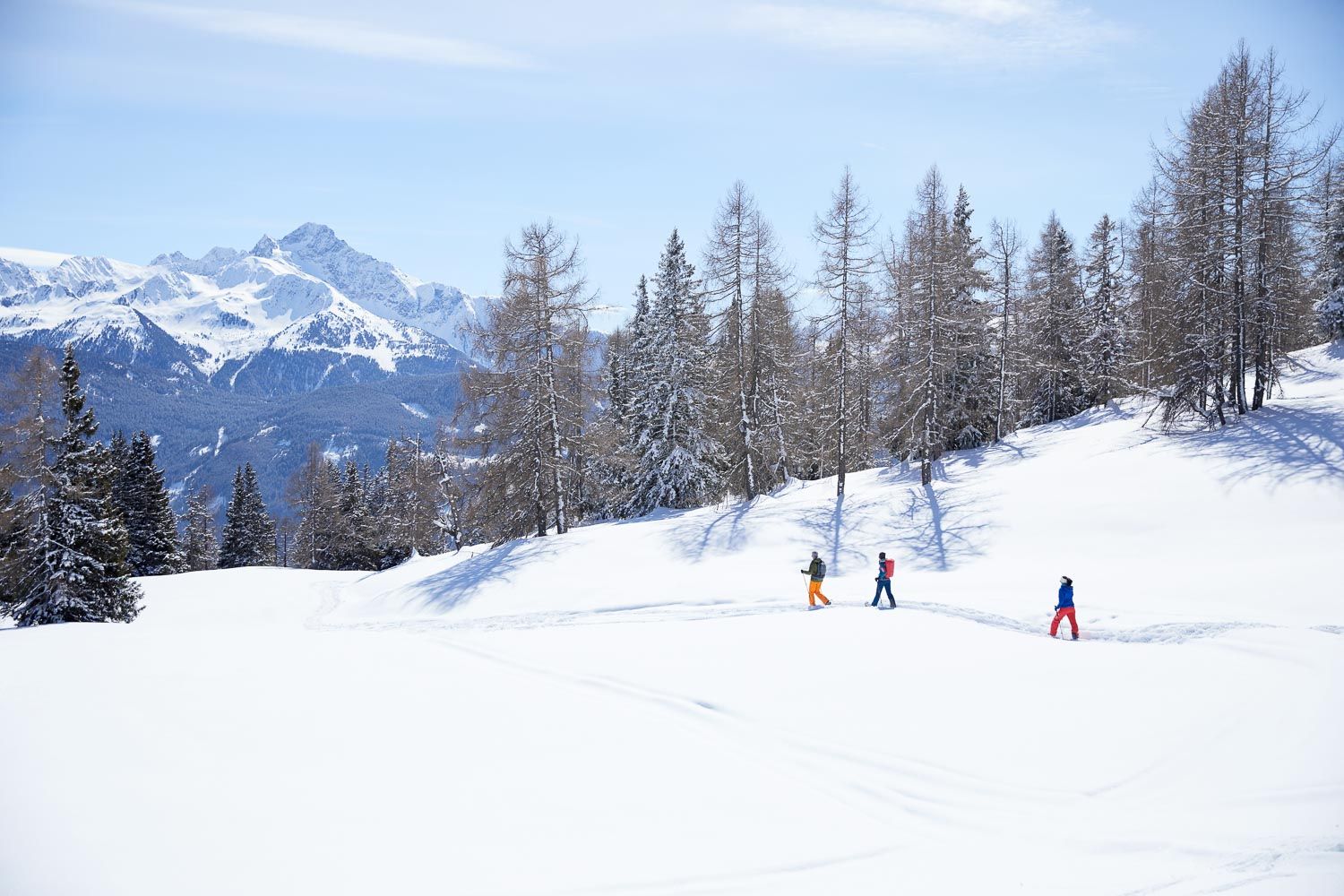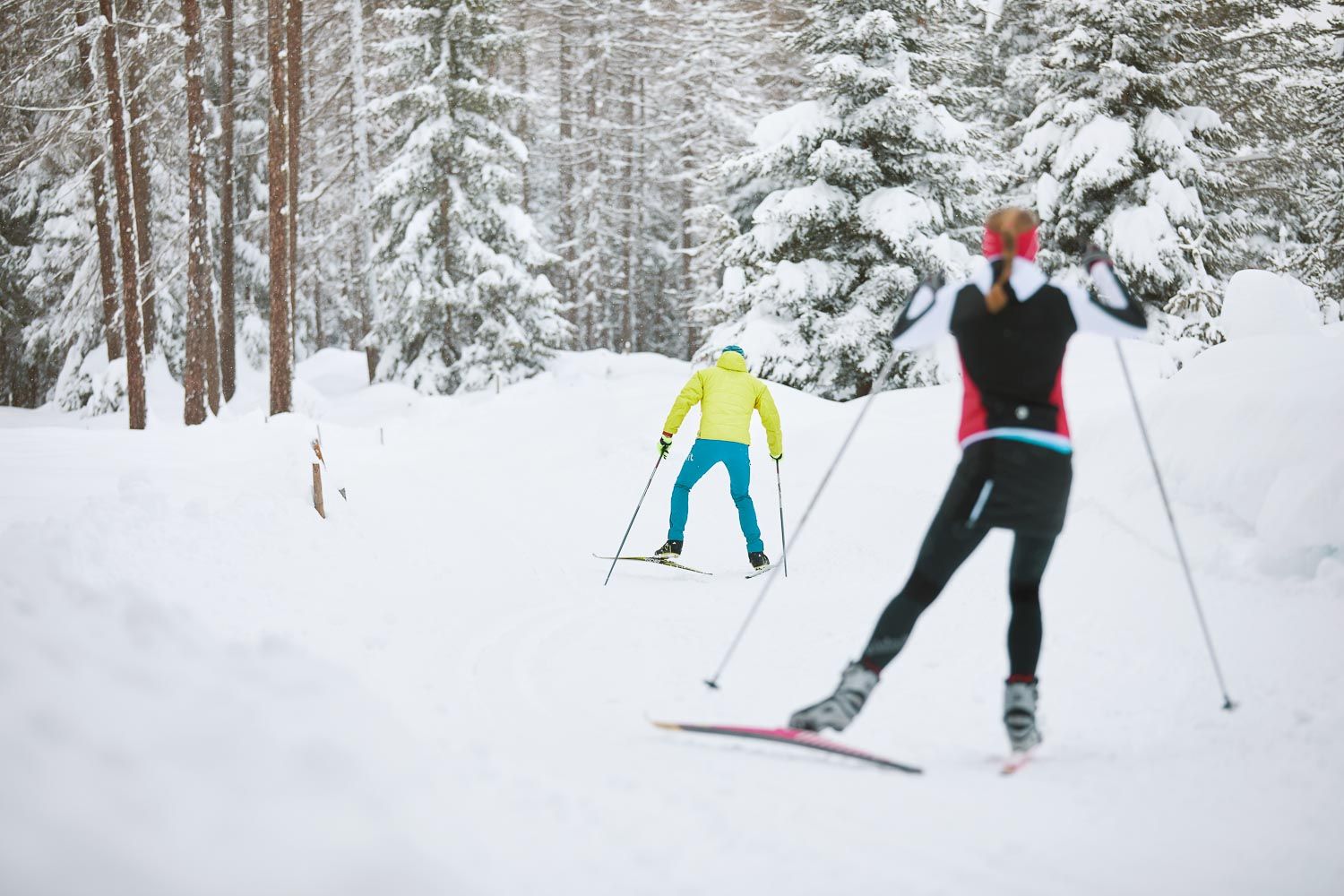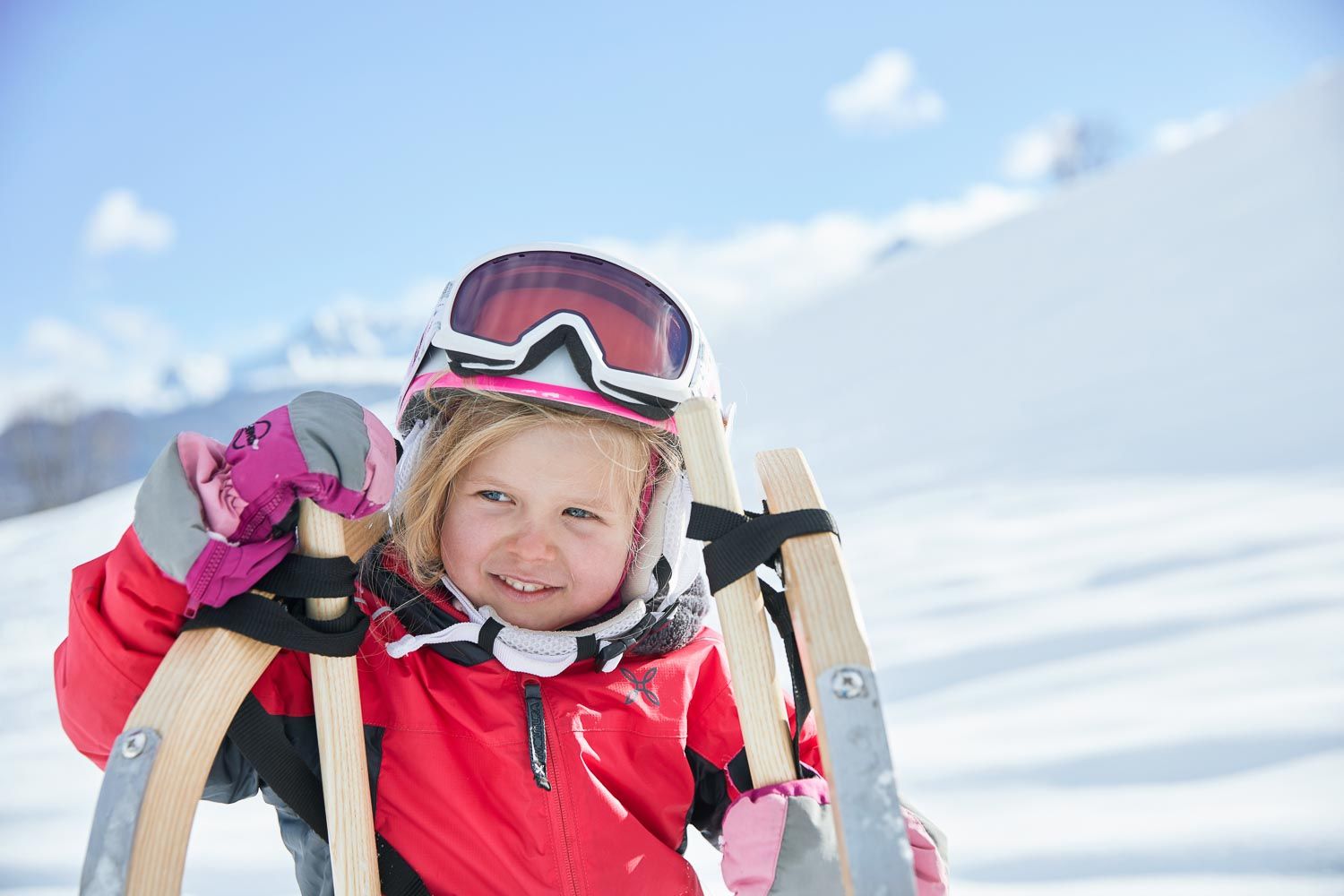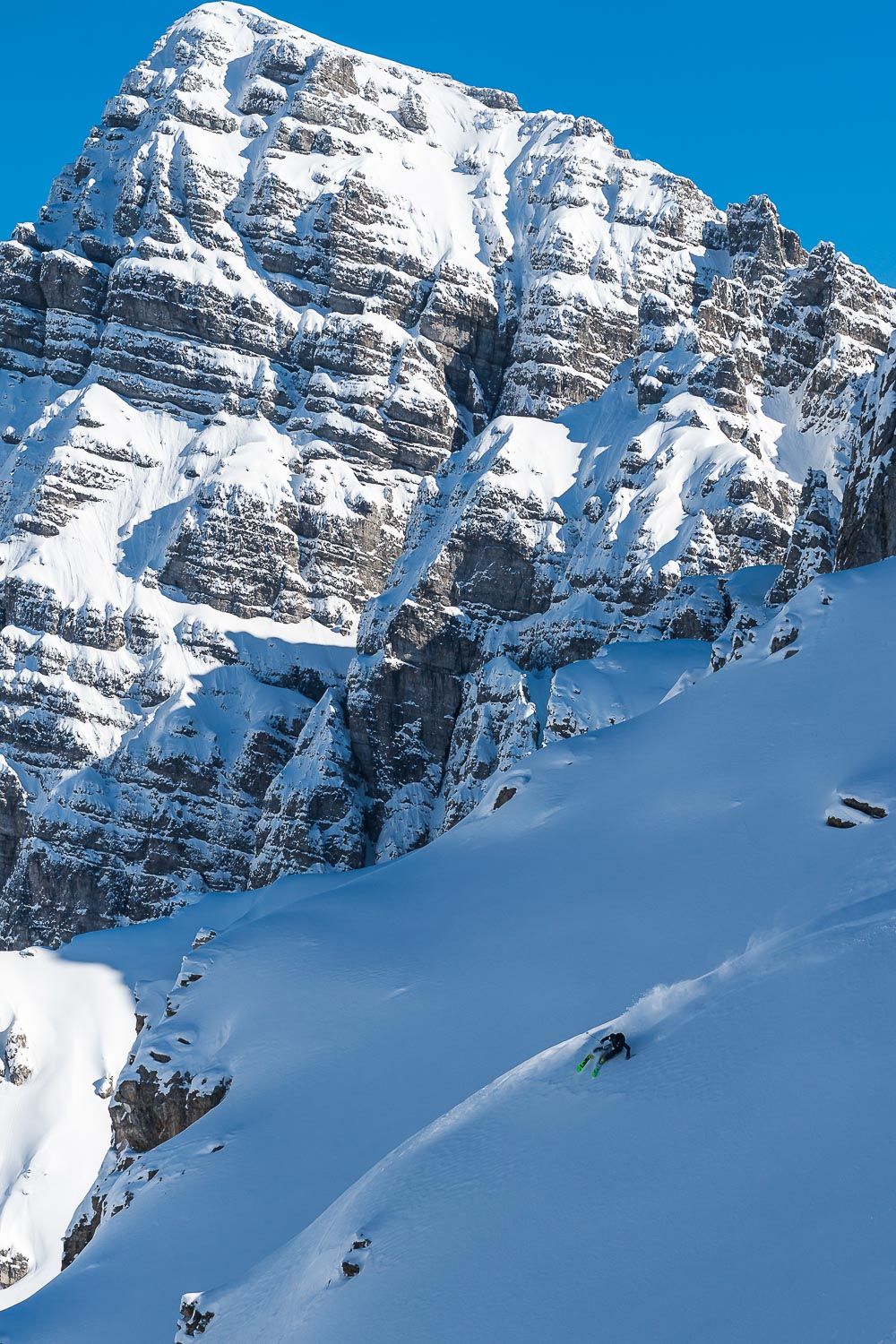Winter fun around Innsbruck
Fresh snow!
Of course, making kilometers on freshly groomed slopes is fantastic. But there is a growing need for less crowding and more nature. Places that slow down life for a while. In the mountains around Innsbruck, the choice is enormous: from snowshoeing on the Mieminger Plateau to ski touring on the flanks above the Sellraintal valley. With a bit of luck there will be a thick layer of fresh snow.
MIEMINGER PLATEAU, FOLLOWING WINTERY ROADS
It is the most beautiful moment of the day during a winter sports holiday. You pull back the curtain on your window and… you see that it snowed last night. And not too shabby, either. Thirty centimeters fresh. The whole world is covered in immaculate white. The landscape has lost its sharp edges and is covered in round, soft shapes.
As soon as the first rays of sunlight peek over the distant mountains, the Mieminger Plateau is bathed in bright light. The Sonnenplateau, as the locals say, lies at an altitude of 850 to 1,000 metres at the foot of a huge limestone wall between the Inntal and the Wetterstein massif. Good for 2,000 hours of sunshine a year and a beautiful view.
Let’s go outside, because this is one of those days you only get to experience a few times a season: fresh snow, blue sky, full sun. Perfect for a hike on snowshoes through the intense silence, only broken by the crunchy sounds of the steps in the snow. The cold makes nose and cheeks glow. You feel that you are outside, that it is healthy.

Innsbruck residents love to come to the plateau. A break from city life for pure nature without being extreme mountains. Ski lifts are also missing. This is a place for hikers, cross-country skiers and winter lovers. In any case, there are plenty of cafes and Jausen stations to rest.
The plateau offers a large network of winter hiking trails, cross-country ski trails or wilderness routes that can only be followed on snowshoes or touring skis. One of the most beautiful places is the hamlet of Weisland, which has existed since the 13th century and looks out over the plateau and mountains on the other side of the Inn Valley. Also beautiful: Simmeringalm with fine warm Almstube.
With a vortex of drifting snow at our heels we descend down the slope.
A feeling of intense freedom races through my body. The whole world feels light, beautiful and uncluttered
Although Mieming is mainly known for Erholung and Genuss, you can also make some challenging tours. Our favourite: Wankspitze. You can reach the 2,209 metre summit via a scenic route past the Lehnberghaus (lunchbreak!) and a steep climb. From the south side, the summit and landscape look friendly, but once at the top, you get to see a different face. The north flank. Whimsical, wild and rugged.
It only makes the finish, back on the Mieminger Plateau, that much nicer. With your back against the old wood of an authentic Gasthof you order Kaffee und Kuchen in the finest winter sunshine. Relaxation guaranteed.
RINNER ALM ON THE SLED
The sun is sinking. Just a few more minutes and it will be dusk on the flanks above Innsbruck. In the city, the first lights are lit. This is the ideal time to start the ascent to the Rinneralm. During the almost hour and a half it takes to do so, the fragile sky changes colour constantly: orange, pink, purple, dark blue.
Walking through a winter fairy tale of snowy trees and up mountains. With the sled on a rope behind you. Occasionally the forest opens up and you can look out over the surroundings. The spectacular peaks of the Nordkette across the valley, the city of Innsbruck below.
Once up at 1,394 metres, the warm hospitality of the Rinner Alm awaits you, as it so often does in Tyrolean in the mountains. A cozy stube, a crackling fire and on the menu freshly madeTyrolean specialties, with classics like Speck– or Kaspressknödel.
Although it is super cozy inside, the best is yet to come: the descent on the toboggan run over natural snow. In the region around Innsbruck you can choose from almost thirty courses, each with their own advantages and disadvantages. Some excel in length, others are excitingly steep. Particularly popular are the Gleirsch Alm (easy), Mutterer Alm (medium) and Sistranser Alm (difficult).
Once outside you immediately feel that it has become cold. With a little luck, the Milky Way will be in the sky. And then it goes down over the track that consists only of natural snow. With an average steepness of 11.7 degrees, you can let the sled run nicely. Lying flat to gain speed, braking and steering in the corners, but not too much to limit the loss of momentum.
The descent is almost four kilometers long and after the finish there is guaranteed to be a big smile on your face. But that could also be due to the mulled wine.
AXAMER LIZUM, OLYMPIC AND FRIENDLY
On the 2,340 meter high summit of Axamer Lizum, skiers have a pleasant problem. Choose. From the women’s Olympic downhill, the women’s Olympic giant slalom or the men’s Olympic giant slalom? Whatever it is, do not hesitate to take the women’s downhill ski run under the summits of Habicht, Widdersberg and Schlicker Seespitze. For the best skiing and for the wow effect.
The slope is wide and has in large parts exactly the right gradient for relaxed cruising. Skis on the sides and make nice round bends. More than half of the route is above the tree line and finally you enter the forest below the charming Dohlennest restaurant. It is characteristic for a ski area that combines making kilometers with cosiness.
After a short rest we took the tram – the Olympia Bahn – up the mountain. It is a vehicle of iron and steel, with a James Bond-like station of concrete at the end. A relic from 1964, when Axamer Lizum was built especially for the Olympics. Until that time this was an alpine pasture, meant to feed the cows in summer. If you look closely, you can still see the cheese maker’s hut at the valley station. Now in use for après-ski.
Just as the city of Innsbruck has revitalised itself with modern architecture and trendy addresses, Axamer Lizum has also made a start on the 21st century. At the top is the restaurant Hoadl Haus, a sleek construction of steel and glass that could have come straight out of the 1960s, but with a contemporary twist. When the weather is nice, the enormous frontage can be opened completely and you can then sit outside in the radiant air and enjoy your Apfelstrudel mit Sahne.

SELLRAIN, CROSS-COUNTRY IN DREAMLIKE SCENERY
They did try it once, in the Sellraintal valley. But the classic winter sports with lifts and slopes has never seriously gotten off the ground. The experiments were soon dismantled, cleaned up and replaced with something more appropriate for the region: winter sports in the open air or Sanfter Tourismus.
Today the Sellraintal is a popular destination for hikers, skiers and cross-country skiers. From the main route, quiet side-valleys lead away from civilization. And that’s exactly where you need to be for a top day in the mountains.
Cross-country skiers will find several trails and a beautiful setting in the Lüsenertal. At the end of the valley the relatively flat bottom of the valley collides with a mountain massif with peaks that rise above 3,000 metres. When you ski down the 5.5 kilometre long Fernboden Loipe or the 11 kilometre long Sportloipe towards the valley end, your horizon is constantly dominated by the 3,298 metre high Lüsener Fernerkogel, the landmark mountain of the region.
The Lüsenertal lends itself perfectly to cross-country skiing as it is elongated and at an altitude of between 1,600 and 1,700 metres. Moreover, in the absence of a ski resort, there is a subdued winter atmosphere of like-minded people. You don’t come here to score as many runs as possible, but to immerse yourself in peace and quiet in the dream setting.

KÜHTAI, SKI TOURING AT ALTITUDE
Kühtai is one of the highest located ski villages in Austria (2,020 m). That’s what it’s known for. But why limit yourself to the ski area’s tightly groomed slopes? With the skins under your skis and an avalanche kit on your back, a new mountain world opens up out there: desolate, pure, quiet.
Climb up by yourself. You do that in the first place for the ultimate reward: an untracked descent through the deep snow. But sometimes walking up is just as beautiful. You search for the right rhythm, the air becomes thinner, the cadence takes over. With that mighty raw mountain world around you, it almost feels like meditation. All earthly cares slip from your shoulders.
The opportunities for ski touring above Kühtai are enormous and, thanks to the high altitude, snow is also guaranteed. From short easy trips to multi-day challenging routes. The classic is the Pirchkogel (2,828 m). The climb with 800 meters of elevation is easy to do and is partly located in the vicinity of the ski area. From the summit-cross you have a spectacular view all around.
The hike to the Wetterkreuzkogel (2,591 m), on the border with the Oetztal, leads through a more exciting environment away from the lifts and slopes. The amount of elevation to be conquered is about the same, but the distance of almost ten kilometres is considerably greater. The best part of this route, however, is the descent. It goes over some nice slopes and sometimes right between the trees.
On a day with half a meter of fresh snow it feels like powderskiing in America.
Ski plus City Pass
Innsbruck is the first city with a ski pass that gives access to slopes, museums and public transport. With the Ski plus City Pass, you’ll have access to 13 ski resorts in the city area and choose from 22 lifestyle, culture and sightseeing attractions such as the Hofburg, Swarovski Kristallwelten, Tyrol Panorama, a city walk, visit to the pool and the Bergisel Springschans, designed by Zaha Hadid, like the Nordkettenbahn. The pass is available from 2 days. A 5-day ticket costs € 244 for adults and € 122 for children.















